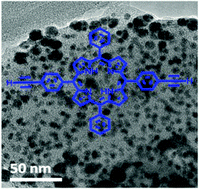Porphyrin-based metallopolymers: synthesis, characterization and pyrolytic study for the generation of magnetic metal nanoparticles†
Abstract
Metallopolymers with different metal centers, pendant groups and linkages exhibit diverse structures and properties, thus giving rise to versatile applications, e.g., as emissive and photovoltaic materials, optical limiters, materials for nano-electronics, information storage, nanopatterning and sensing, macromolecular catalysts and artificial enzymes, and stimuli-responsive materials. Recently, metallopolymers as precursors to generate monometallic or metal alloy nanoparticles are of great interest owing to their advantages of ease of processability, atomic level mixing, and stoichiometric control over composition. By taking advantage of the template effect of porphyrin compounds, a series of monometallic and heterobimetallic polymers are synthesized which are characterized by NMR, IR, HRMS, EA, GPC and TGA, respectively. Photophysical properties of these metallopolymers are also studied by UV-vis spectroscopy. Pyrolytic treatment of these metallopolymers generates various magnetic monometallic and metal alloy nanoparticles which can be used in data storage, catalysis, biomedicine, etc.


 Please wait while we load your content...
Please wait while we load your content...